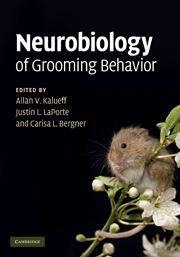Book contents
- Frontmatter
- Contents
- List of contributors
- Preface
- 1 Grooming, sequencing, and beyond: how it all began
- 2 Self-grooming as a form of olfactory communication in meadow voles and prairie voles (Microtus spp.)
- 3 Phenotyping and genetics of rodent grooming and barbering: utility for experimental neuroscience research
- 4 Social play, social grooming, and the regulation of social relationships
- 5 Grooming syntax as a sensitive measure of the effects of subchronic PCP treatment in rats
- 6 Modulatory effects of estrogens on grooming and related behaviors
- 7 Lack of barbering behavior in the phospholipase Cβ1 mutant mouse: a model animal for schizophrenia
- 8 Grooming after cerebellar, basal ganglia, and neocortical lesions
- 9 Striatal implementation of action sequences and more: grooming chains, inhibitory gating, and the relative reward effect
- 10 An ethological analysis of barbering behavior
- 11 Should there be a category: “grooming disorders?”
- 12 Neurobiology of trichotillomania
- Index
- References
1 - Grooming, sequencing, and beyond: how it all began
Published online by Cambridge University Press: 04 August 2010
- Frontmatter
- Contents
- List of contributors
- Preface
- 1 Grooming, sequencing, and beyond: how it all began
- 2 Self-grooming as a form of olfactory communication in meadow voles and prairie voles (Microtus spp.)
- 3 Phenotyping and genetics of rodent grooming and barbering: utility for experimental neuroscience research
- 4 Social play, social grooming, and the regulation of social relationships
- 5 Grooming syntax as a sensitive measure of the effects of subchronic PCP treatment in rats
- 6 Modulatory effects of estrogens on grooming and related behaviors
- 7 Lack of barbering behavior in the phospholipase Cβ1 mutant mouse: a model animal for schizophrenia
- 8 Grooming after cerebellar, basal ganglia, and neocortical lesions
- 9 Striatal implementation of action sequences and more: grooming chains, inhibitory gating, and the relative reward effect
- 10 An ethological analysis of barbering behavior
- 11 Should there be a category: “grooming disorders?”
- 12 Neurobiology of trichotillomania
- Index
- References
Summary
Summary
This chapter has taken two distinctive but complementary approaches to mouse grooming. The first is based upon Frances Stilwell's intuitive perceptions in the 1970s of previously unappreciated order in grooming sequences. An important principle here is that early stages in research depend upon sensitivity to what our animals can show us. Premature narrowing of observational perspective can limit the richness of analytical questions that are initially hidden from view. In the second part of the chapter, John Fentress outlines some of the richness of subsequent research that sensitive descriptions have led up to. Mouse grooming has led to a host of studies in behavioral genetics, development, brain mechanisms, and motivational models including stress.
Introduction
This chapter is intentionally divided into two parts. The first part, by Frances Stilwell, outlines the discovery of rules underlying order in the rich patterning of mouse grooming. As Stilwell discovered in the early 1970s, there is indeed syntax, perhaps even a grammar, in these rodent movements. One of the lessons here is to look closely at rules of order in seemingly inconsequential action patterns of the animals around us. They are rich in their structure. Mouse grooming has led to a number of important insights about brain and behavior. Furthermore, Stilwell's comments are not only refreshingly personal, but also important as a picture of how research sometimes actually progresses. This reminds us of the insights early ethologists, such as N. Tinbergen, came up with by just watching.
- Type
- Chapter
- Information
- Neurobiology of Grooming Behavior , pp. 1 - 18Publisher: Cambridge University PressPrint publication year: 2010



